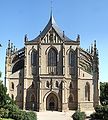Benedikt Rejt
Benedikt Rejt | |
|---|---|
Gothic style, sometimes with Renaissance elements (so called Jagiellonian Gothic ) |
Benedikt Rejt (often spelled Benedikt Ried
Historical context
Bohemia became the cultural center of Central Europe when Charles IV brought the Holy Roman Emperor's court to Prague in the 14th century. The Royal Court Workshop under the guidance of Peter Parler was one of the highlights of Gothic architecture in the Holy Roman Empire. The Hussite Wars then stopped all plans for cultural development in the region for many decades.
When Bohemia was again open to Europe after 1480, during the reign of
Life
There is little information about Rejt from historical sources. The dates of birth and death are unclear as well as the place of origin or early life activity (Mencl guesses the
After 1500 he was often referred to as Master Benedikt and a Prague architect and stonemason hired by the
In 1518, Rejt was a chairman and key participant at the congress of architects and stonemasons from all of Central Europe in Annaberg, Saxony.[1] Many hints in historical sources are disputable. According to some of them Rejt came to Prague as a military engineer to rebuild the Prague Castle fortification (he may have built the walls of the castles Rabí and Švihov as well).[2] He then became famous for his skills in the art of Late Gothic vaults, in which art he reached one of the peaks in all medieval architecture. Earlier he was considered an inventor of the tent roof of cathedrals (now typical for churches in Kutná Hora and Louny), but it has been discovered from medieval pictures that their use was more common, and Rejt was probably not an exclusive builder of them.[2] His direct pupil was Jacob Haylmann von Schweinfurt, who worked with him in Kutná Hora and Annaberg.[1]
Work (with his important participation)
Prague Castle
- Vladislav Hall, the largest medieval vaulted secular room in Europe, completed in 1500
Ludvík Wing (Louis Palace), considered to be the first Renaissance building in Bohemia (with examples in Italy), later the place of the Second Defenestration of Prague
Knight's Stairway with an original vault arrangement - Fortification with the towers of Mihulka and Daliborka (the jail of Bedřich Smetana's opera Dalibor)
- Plans for completing St. Vitus Cathedral, begun but discontinued
Bohemia
- St. Barbara's Church in Kutná Hora, from 1512 onward on the aisle and vault,[1] supervised by Jacob Haylmann von Schweinfurt and a Hans, after Rejt's death by Master Mikuláš and Jan Vlach, tent roof realized by Master Vaněk; restored in 1884–93 by Josef Mocker and Ludvík Lábler[3]
- St. Nicholas Church in Louny, from 1519,[1] supervised by Pavel of Pardubice and Filip of Wimpfen, probably Rejt's disciples; restored in 1885–92 by Josef Mocker and 1898–1902 by Kamil Hilbert[4]
- Church of the Assumption of the Virgin Mary in Most, mentions of Jörg of Maulbronn; restored in 1882;[3] moved 841 metres to make room for the expanding lignite mines in 1975
- Villa in Stromovka (Bubeneč)
Outside Bohemia
- St. Anne's Church in Annaberg
- Castle in Münsterberg nobility from 1524 onward[1]
Work of more disputable authorship
Buildings usually assigned to Johannes Spiess (Hans, Hanuš)
- Royal Oratory in St. Vitus Cathedral
- Vladislav bedroom in Old Palace of Prague Castle
- Parts of St. Peter and Paul's Church in Mělník Palace, chapel and other rooms in Křivoklát Castle
Property of Půta Švihovský of Rýzmberk
- Švihov Castle, in 1505,[1] fortification system of the moated castle[5]
- Rabí Castle, fortification system of one of the largest castles in Bohemia[5]
Property of Zdeněk Lev of Rožmitál
- Palace of Zdeněk Lev of Rožmitál in Hradčany
- Blatná Castle, 1523–1530[1]
Others
- Virgin Mary Chapel (donated by Viktorin Špulíř) in the Church of the Assumption in Jindřichův Hradec, completed in 1506[6]
- Virgin Mary Chapel on Náměť in Kutná Hora, the burial place of Petr Brandl, assigned to Master Blažek from Kutná Hora[6]
- The vault of the Church of the Assumption in Ústí nad Labem, damaged in WWII[6]
- The castle in Březnice, fortification after 1531[4]
Beneš of Louny
In the 19th century, Czech patriots made efforts to claim that Benedikt Rejt had Czech or Bohemian ancestry. In many sources from that time he is referred to under the name Beneš of Louny, e.g., in the Hall of Fame in the 1891 building of National Museum in Prague. According to tradition, he was buried in St. Nicholas Church in Louny. In 1906, Zikmund Winter concluded the discussion with convincing evidence that Rejt was of German origin and that he learnt Czech as fluently as German, as he could be considered Czech (his offspring identified with Czech nationality).[2]
Legacy
A gallery and a square are named after Rejt in Louny. There is also a 20th-century statue of Benedikt Rejt holding a
Gallery of selected works
-
St. Barbara's Church in Kutná Hora
-
Church of St. Nicholas in Louny
-
Vladislav Hall at Prague Castle
-
Church of the Assumption of the Virgin Mary in Most
Notes
References
- ^ a b c d e f g h i j Václav Mencl: Architektura, in: Pozdně gotické uměnív Čechách, Odeon Prague 1978 (in Czech)
- ^ ISBN 978-80-200-1744-4(in Czech)
- ^ a b ed. Emanuel Poche: Umělecké památky Čech 2, Academia Prague 1978
- ^ a b ed. Emanuel Poche: Umělecké památky Čech 4, Academia Prague 1982
- ^ a b ed. Emanuel Poche: Umělecké památky Čech 3, Academia Prague 1980
- ^ a b c ed. Zdeněk Wirth: Dějepis výtvarného umění v Čechách, I. díl Středověk, Prague 1931
Further reading
- Pavel Kalina: European Diplomacy, Family Strategies, and the Origins of Renaissance Architecture in Central and Eastern Europe.Artibus et Historiae. Vol. 30, No. 60 (2009), pp. 173–190




